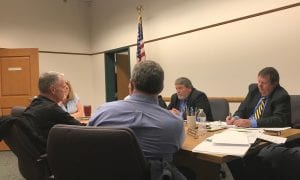WESTFIELD – A city resident, speaking during public participation at the Municipal Light Board meeting Wednesday, inquired about the status of the high-pressure Southwick Lateral Pipeline project.
Barbara Rokosz of 272 Lockhouse Road asked the status of the project and who is bearing the cost of that work.
Rokosz also questioned the financial obligation of the Pioneer Valley Energy Center, a $400 million gas-fired generation plant which recently received the last permit needed to construct the 430 megawatt facility, although there is still a pending appeal of a permit issued by a state agency.
Westfield Gas & Electric Department General manager Dan Howard said the municipal utility installed a 12-inch, thick-walled pipeline designed to carry gas at between 600 and 700 pounds per square inch (PSI), from the utility’s gatehouse at the Tennessee gas pipeline, which supplies the region with natural gas. That 12-inch pipeline is buried under the former New Haven-Northampton railroad track which is being converted to a bicycle trail.
The department initially brought the line to Shaker Road, work done in coordination with Southwick, which was constructing its portion of the bicycle trail from the Granby, Connecticut line to the Westfield Line. The Southwick trail is linked to about 30 miles of the trail in Connecticut.
The WG&E extended the pipeline this spring to South Meadow Road because the city received a grant to construct the first phase of its portion of the Columbia Greenway rail trail from the Southwick line, across Shaker Road, to an area near Tin Bridge.
Howard said the utility extended a 10-inch line from the 12-inch main. The 10-inch line is connected to a series of lines installed during the Broad Street and the Great River Bridge projects to carry gas to the Union Street plant for distribution throughout the city.
Howard said that he informed PVEC Project Manager Matt Palmer that the department has no intention of extending the 12-inch line and that any extension of the line will be the responsibility of the power plant owners.
Howard said that the power plant is also responsible for the “incremental cost” of installing the 12-inch, high pressure line instead of the smaller, thin walled pipeline as originally designed for the project. The change to the high-pressure line was made at the request of the PVEC project managers.
That request was made because the gas turbines need a supply of natural gas at between 600 and 700 PSI to operate efficiently.
“If they build the plant, they will have to extend the 12-inch line at their expense,” Howard said, adding that the work will have to be done in coordination with the city as it extends the Columbia Greenway through the downtown, work that will be done in several phases.
Palmer said Thursday that he has been in communication with both Howard and City Advancement Officer Jeff Daley concerning a timeline for the rail trail extension work.
“We’re fully prepared to work with the city to ensure that the pipeline is installed before the rail trail is extended,” Palmer said. “We have an understanding of a likely timetable.”
Palmer said that all of the required local, state and federal permits “are in place.”
“There is one last appeal of our superseding order of conditions issued by the DEP (state Department of Environmental Protection) following an appeal of the order of conditions issued by the city’s Conservation Commission,” Palmer said. “The DEP issued its superseding order of conditions on June 13 and the appeal was filed June 20 by the same group which has appealed all of these permits. Every appeal has been resolved in our favor without substantive change to the permit.”
The latest appeal will be reviewed by a DEP hearing officer and that decision of that officer can them be appealed in superior court.
Palmer said those appeals have slowed the generator construction project, but that delay has better positioned the project as the economy continues to recover.
“The economy cuts both ways, but we’ve landed in a pretty good spot,” Palmer said. “Contractors are still hungry for work. The project will add jobs to the economy and as the economic bounce back continues we’ll start producing power in 2016.”
The DEP expanded the wetland delineation during its review of the Conservation Commission order of conditions.






